by Susan Ndiaye, Community Horticulture Educator
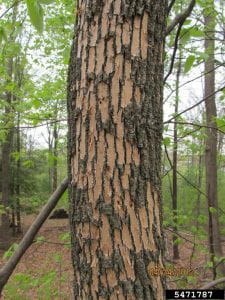
Hopefully you’ve spent some time outside enjoying the beautiful spring weather we had last weekend. Did you noticed any ash trees that look like they have been completely stripped of their bark? Did you wonder what happened? Did you think it was a disease, an insect or maybe a deer? This damaged is actually caused by woodpeckers. They are searching for emerald ash borer larvae which can be found just below the bark.
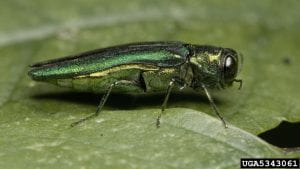
The emerald ash borer (Agrilus planipennis) is an shiny emerald-colored jewel beetle. Native to Asia, it was first discovered in North America near Detroit, Michigan in 2002 (most likely hitching a ride here in solid wood packing materials used in the transportation of goods).
Despite its beauty, the emerald ash borer is an invasive insect and has killed hundreds of millions of ash trees throughout North America. As of April 2020, it has been found in 35 states and 5 Canadian provinces costing municipalities, property owners, nursery operators and forestry product industries hundreds of millions of dollars.
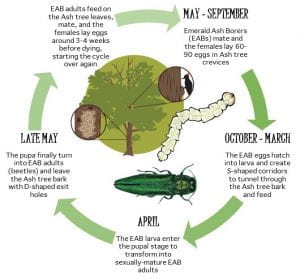 Lifecycle
Lifecycle
Emerald ash borers, like all beetles, undergo complete metamorphosis. Usually in June and July, adult females lay 60-90 eggs on the bark of ash trees (Fraxinus spp.). The eggs hatch and the larvae bore through the outer bark and begin feeding on the inner bark or phloem of the ash tree. The larvae feed for several weeks growing to rough 1 to 1.25 inches in length. The larvae then overwinter in the bark. In the spring they pupate and finally in May and June emerge as adults and exit their host tree by creating a D-shaped whole in the bark. The adults feed on the leaves of the ash tree, mate, and females lay eggs starting the cycle over.
Damage
As mentioned before, the larvae of the emerald ash borer feed on the inner bark or phloem of the ash tree. The phloem is part of the vascular system of the plant and is responsible for transporting the sugars produced by photosynthesis in the leaves to the rest of tree. Damage to the phloem cuts of the nutrient supply and eventually leads to the death of the tree.
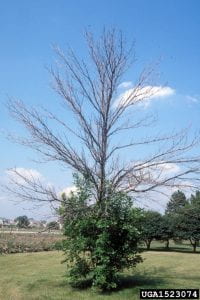
One of the first symptoms produced by an emerald ash borer infestation is a thinning canopy. With fewer leaves the tree’s ability to produce food through photosynthesis decreases and as a result the tree may produce lots of shoots that sprout from the roots and trunk. The leaves on these shoots are often larger than normal as the tree tries to compensate for its loss of photosynthetic capability. The tree’s canopy will continue to thin eventually leaving the tree bare.
Many people do not notice that the canopy of their ash tree is thinning. For many people, the first symptom that they notice is the woodpecker damage on the trunk. At this point the tree is usually heavily infested by emerald ash borer and will soon succumb to the infestation.
Management
The emerald ash borer was first detected in New York State in 2009 over in Cattaraugus County. Two years later, in 2011, it was detected here in Orange County. As of right now the majority of trees in Orange County have been infested by the emerald ash borer and are showing signs of decline or have died. Once you notice that the canopy of your ash tree is thinning there has already been extensive damage to the vascular system of the tree and even with treatment there is little chance of recovery.
Deciding whether or not to treat your ash tree is up to you. The first thing to do is make sure you properly identify your tree.
Once you have properly identified your tree there are three option: cut it, treat it, or leave it.
Cut It
Ash trees that create a potential hazard (i.e. proximity to a building) need to be removed. If you cannot safely remove the tree yourself, look for a certified arborist near you at www.treesaregood.org. Many ash trees are being turned into firewood. Keep in mind that New York State law prohibits the movement of firewood more than 50 miles (linear distance) from its source, specifically to prevent the accidental movement of invasive species like the emerald ash borer. Don’t Move Firewood!
Treat It
Remember that that if you tree is already showing signs of decline it is probably too late to save it through treatment.
If you decide you want to treat your ash tree(s), it is not just a one time investment. Most treatments only last one or two years before they wear off leaving the tree susceptible to infestation. This means trees need to be treated ever couple years since at the moment the emerald ash borer looks like it is here to stay.
There are many insecticides on the market that are labeled for emerald ash borer. Many of them need to be applied by a certified pesticide applicator. If you are interested in protecting your ash tree(s) check out Insecticide Options for Protecting Ash Trees from Emerald Ash Borer for more information.
Leave It
If your ash tree poses no potential hazard, consider leaving it. Although the emerald ash borer has killed millions of ash trees here in North America, there is hope the identification of “lingering ash” or an ash that stays healthy after nearby trees have overwhelmingly succumbed to the emerald ash borer. The identification of “lingering ash” could help achieve ash species conservation. Click here to learn more about how you can become a citizen scientist with the Lingering Ash Search through the Monitoring and Managing Ash Program.
Fun Facts
Biological Control
Although there are some predatory wasps that feed on emerald ash borers, the two avenues of biological control that have shown potential in being able to help manage populations of emerald ash borer are parasitoid wasps and entomopathogenic fungi.
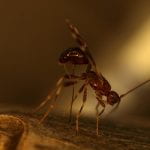
Let’s start with the parasitoid wasps. Three species of parasitoid wasps found in the emerald ash borer’s native range were were considered potential biological control agents. These parasitoids are natural enemies of the emerald ash borer and have long ovipositors that allow them to drill into the ash trees and lay their eggs on the emerald ash borer larvae. Once the eggs hatch the wasp larvae consume the emerald ash borer larvae alive. (Note: In order to get permission to release these parasitoid wasps in the United Stated, it took four or five years of research to make sure that they were host specific to emerald ash borer and wouldn’t impact any other similar species.) Of the three species released, two are showing promise, although research is still being done regarding their dispersal, spread, and ability to overwinter.
Onto the entomopathogenic fungus, Beauveria bassiana. When spores of this fungus come in contact with the emerald ash borer, they germinate and penetrate the cuticle of the insect. The fungus continues growing inside the insect eventually killing it. Although research has show that this fungus can kill the emerald ash borer, more research is need to see if it is effective form a biological control out in the field.
Phenology
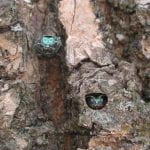
Many things in nature are governed by the weather, such as the hatching of bagworm eggs and in this case the emergence of emerald ash borer adults. You can track this year’s emergence using the “Emerald Ash Borer Forecast“. This forecast is updated daily and available six days in the future. Emerald ash borer adults are rarely seen. Once they emerge, they fly up into the canopy to feed on the leaves. But if you know when they are emerging you can be on the look out and might be lucky enough to find one.
The Oleaceae Family
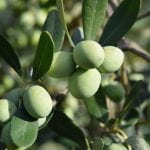
The ash tree is a member of the Oleacae Family and researchers have found that the emerald ash borer can also complete its life cycle in another well-known member of the Oleacae family, the olive tree (Olea europaea). Although this has only been shown in a laboratory project, there is a possibility that the emerald ash borer could become a problem for olive growers.
Another member of the Oleacae family, the white fringetree (Chionanthus virginicus) is also used as a host for the emerald ash borer. Although when infested some of these trees don’t survive, a recent study found that white fringetrees are likely to withstand attacks by the emerald ash borer.
Resources
Ash Tree Identification – Michigan State University Extension
Distinguishing Ash from other Common Trees – Michigan State University Extension
Emerald Ash Borer Information Network
Emerald Ash Borer Forecast – National Phenology Network
Insecticide Options for Protecting Ash Trees from Emerald Ash Borer
Signs and Symptoms of the Emerald Ash Borer – Michigan State University Extension
